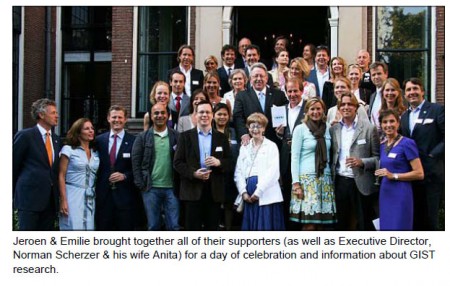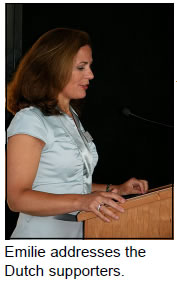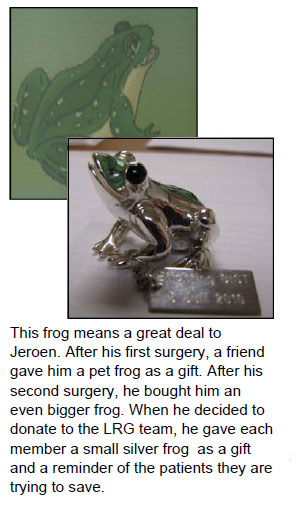“Why are we so passive?” Jeroen Pit asks, “If everyone sits still, not much is going to happen.”
A successful Dutch businessman, Jeroen has never been a passive man. When he was diagnosed with GIST in May 2006, he made his GIST decisions much like he would make business decisions— methodically and with clear purpose.
In June, Jeroen had surgery in Holland to remove a primary GIST tumor. When his GIST metastasized to the liver, he and his wife, Emilie, made the decision to travel to Memorial Sloan-Kettering Cancer Center in New York City. He began 400 mg of Gleevec and eventually, in late 2007, underwent another surgery on his remaining liver metastases.
Unfortunately, in late 2009, progression forced Jeroen to discontinue Gleevec and he was placed on Sutent. Initial scans showed a positive response.
After numerous surgeries, procedures and drug changes, Jeroen asked himself what was next on his list? It was time to fundraise.
“We wanted to be able to say to ourselves, ‘At least we did everything we could. At least we don’t blame ourselves.’”
Jeroen got on the internet and started his investigation into the GIST research landscape.
“I wanted to know if my fundraising efforts would make a difference. What are the amounts researchers are working with and who are the key researchers in the field?” said Pit.
Once satisfied that he could indeed make a difference, Jeroen got in touch with Dr. Maria Debiec- Rychter of the Catholic University in Leuven, Belgium, who told him about the LRG Research Team.
In November 2009, Jeroen & Emilie met with LRG Executive Director, Norman Scherzer to discuss research and fundraising opportunities.
“Norman is inspiring,” Jeroen recalls, “I went home and thought, ‘We can make a difference and this research team is the right choice.’”
“Other [research] alternatives were good,” he adds, “But the impact of your dollar is better at the LRG.”
This impact stems from a number of areas in which the LRG research team differs from traditional cancer research. The LRG eliminates the overhead costs institutions usually taken, which can range from 50 to 75 percent of the donation. In addition, the LRG research team stresses collaboration and sharing amongst its researchers, who are required to meet in person, as well as submit routine progress reports.
While Jeroen worked on a way to enhance GIST research, his GIST tumors had an entirely different plan. Jeroen was beginning to fail Sutent.
Over the next few months, Jeroen would undergo radiation, RFA and embolization treatments to control his metastases. In March, his doctors at MSK decided to start him on Nexavar.
With another hurdle overcome, Jeroen began to think about a fundraising plan again.
“In April, my CT scan showed that Nexavar was working, so we decided to go for it.”
Choosing a quality over quantity approach, Jeroen asked a small group of people to donate larger amounts then he normally might. His plan worked.
Within a matter of weeks, Jeroen had raised over 1.7 million euros for GIST research, roughly two million dollars.
“[That approach] was easier for me because of my network of colleagues.”
But Jeroen wasn’t satisfied with handing a check over without assurances
 that there was a firm plan in mind for his hard work.
that there was a firm plan in mind for his hard work.
Using the combined ingenuity of the LRG research team, a new plan was formed: Project D Day.
Taking the knowledge, understanding and achievements the researchers have acquired in the last four years, the team would launch a four-pronged strategic attack on GIST treatment resistance.
The four distinct project areas are sequencing, gene knockdown, drug screening and validation. Each of these complex areas would have a unique team leader to ensure maximum coordination, communication and assess progress at all times.
“The sequencing and knockdown project areas will enable researchers to understand what is going on in GIST tumors,” says Pit.
Ever mindful of his personal struggles with GIST, Jeroen made sure drug screening would be a part of the research plan. This research, which involves testing GIST cells against thousands of drugs and compounds, is specifically targeted at those patients who have failed first-line treatment.
“Every patient thinks to themselves, what if Gleevec doesn’t work anymore?”
Why are we so passive?
With Project D Day underway, Jeroen is proud of what he and his family have accomplished. But he still wonders why this type of effort is not more common in the GIST community.
Because GIST is such a rare disease, funding by government and most pharmaceutical companies is very difficult. This makes GIST research largely dependent on private donations.
“If GIST cases in the US range from 5,000 to 10,000 diagnosed a year, and 10,000 people donated just ten dollars a month, we would have 1.2 million dollars a year for GIST research.”
Jeroen encourages others to follow his lead and spearhead their own fundraising efforts by reaching out to friends and colleagues.
“You can only create when you do things together.”
While Jeroen’s situation may seem different, the principles are still the same. “Put it on paper,” he says, “By writing, you further develop your proposition.”
Using information from LRG researchers about past achievements and future plans, Jeroen created and circulated a brochure addressing why donating is important and the impact of private donations.
As for Jeroen, he still continues on Nexavar and has recently taken up the mantle of spreading awareness of GIST treaments in the Netherlands (probably the next item on his To Do list).
But with Project D Day finally a reality, he can’t help looking forward just a little, “I really think they are going to find something that will help us all.”

